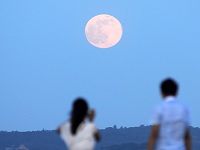
Announcement
MHCC Planetarium Sky Theater, Autumnal Astronomical Adventures: Thu Sep 24, 2015 6-8PM
 Autumn Night Sky MHCC Planetarium website |
Autumnal Astronomical AdventuresWhen: Thu Sep 24, 2015 |
Admission $5. MHCC students $2.
The Sky Theater is wheelchair accessible.
Autumnal Astronomical Adventures
Join us for a tour of the night sky where you'll whiz through universe from the comfort of your seat! 2 shows starting at 6:00PM and 7:15PM.
The Mt. Hood Community College (MHCC) Planetarium invites you enjoy another year of great public shows using their state-of-the-art digital star projection system.
Each show is presented under a realistic representation of the night sky, featuring the latest galactic, stellar and planetary images. Visitors are encouraged to ask questions during each program. Children are welcome to attend.
Rockwood Farmers Market, Farm Fresh Produce: Fri Sep 25, 2015 3PM-7PM

|
Farm Fresh Produce!When: Friday May 29-Oct 30 3PM-7PM |
The Rockwood Farmers Market is a community-focused market featuring fresh produce from local farms in a welcoming and vibrant atmosphere. WIC, SNAP and Farm Direct coupons are accepted. Use your EBT funds at the market and we'll match the first $5 so you have even more money to spend on fresh fruits and vegetables to bring home! The Market is a collaboration of Ecumenical Ministries of Oregon’s Interfaith Food & Farms Partnership and the Rockwood Co-op.
Visit the Rockwood Farmers Market website or Facebook page.
Gresham Farmers' Market brings fresh produce, crafts and more: Sat Sep 26, 2015 8:30AM-2PM

|
Saturdays May thru October!When: Every Saturday, 8:30AM-2PM |
Fresh & Local
Shoppers will find all-natural meats and cheeses, fresh-picked produce, nursery stock and fresh-cut flowers, hand-crafted jewelry, soaps, artwork, and much more. Live music and food are always part of the market.
Located on Northwest Miller Avenue between Second and Third Street 8:30AM to 2PM each Saturday now through Oct. 25.
Bring the Kids to the 33nd Annual Teddy Bear Parade, Historic Downtown Gresham: Sat Sep 26, 2015 10AM-12PM
 Annual Teddy Bear Parade |
Bring a Bear, Donate a Book!When: Sat, Sep 26, 2015 10AM-12PM |
Participants and spectators are invited to bring a new or gently used children’s book (appropriate for ages 5 to 12), for schools in the area.
Teddy Bears Everwhere
The parade will feature floats from local merchants, service organizations, schools, neighborhood groups and individuals. As always, participants will be carrying teddy bears or will be dressed in bear costumes.
For over three decades, the Soroptimists have put on this annual Fall parade to celebrate the “child in all of us” and create a tradition that helped Gresham’s “quaint and special downtown area” to thrive. In addition to the parade, the Soroptimists organize fundraisers throughout the year to raise money for scholarships for deserving women and girls in our community.
Gresham Saturday Market: Sat Sep 26, 2015 9AM-3PM

Rain or Shine EventWhen: Sat thru Sep 26, 9AM-3PM |
The Gresham Saturday Market offers a rich mix of regional, farm-grown goods, handcrafted products, fine art, unique gifts, fresh food and live music. |
Located in the NE corner of the Gresham KMart parking lot bordered by Eastman Pky and NW Burnside Rd
Bike Helmet Giveaway! Transportation Safety Fair and Bike Rodeo: Sat Sep 26, 2015 11:30AM-2:30PM

|
Helmet Giveaway, Bike RodeoWhen: Sat Sep 26, 2015 11:30AM-2:30PM |
To promote bicycle safety and a healthy lifestyle and educate the community about bikes on public transit, the City is partnering with the Oregon Nurses Association (ONA) to hold the annual Transportation Safety Fair and Bike Rodeo.
Helmet Giveaway
- The ONA Constituent Association 1 has purchased hundreds of bicycle helmets to give away to children and adults who are not able to purchase new helmets.
- Children must check in with a parent or guardian to pick out color and style of the helmet they want. A trained volunteer will fit the helmet, demonstrating proper fitting.
- The ONA has first-hand knowledge of the importance of teaching safe biking skills to children in order to prevent severe injuries from accidents, and has fitted more than 1,500 free bicycle helmets in the Portland metro area since 2007 to promote injury prevention.
Bike Rodeo
- Bring Your Bike and Helmet!
- Bring your bike and have it checked by a trained mechanic from Bikes for Humanity PDX.
- Learn the rules of the road from Gresham bike patrol officers, and practice riding on a safety course.
The Bike Rodeo is presented by the City's Transportation Planning Division staff, volunteers, and Boy and Girl Scouts, with help from the Gresham Police.
Group Bike Ride
A group bike ride will begin at the safety information booth on the Arts Plaza, traveling through downtown Gresham to Main City Park, making a loop on the Springwater and Gresham-Fairview Trails, and returning to the Arts Plaza around 2:30 p.m.
More Info
For information or to volunteer at this event contact Sandra Doubleday at 503-618-2816 or Sandra.Doubleday@GreshamOregon.gov.
Magical treat for skywatchers! Stunning Supermoon Lunar Eclipse, Tonight: Sun Sep 27, 2015 7PM

|
Not Again Until 2033!When: Sun Sep 27, 2015 5PM-9PM |
Source: Space.com
This month's highly anticipated "supermoon eclipse" will be a magical treat for skywatchers!
On Sept. 27, skywatchers throughout North and South America, Europe, Africa, western Asia and the eastern Pacific Ocean region will witness a total eclipse that happens to occur when the moon looks abnormally large and bright in Earth's sky. It will be the first supermoon eclipse since 1982, and the last until 2033.
When the moon is farthest away, it's known as apogee, and when it’s closest, it's known as perigee. On Sept. 27, we're going to have a perigee full moon — the closest full moon of the year.
The moon is about 31,000 miles (50,000 kilometers) closer to Earth at perigee than it is at apogee. As a result, perigee full moons, also known as supermoons, appear about 14 percent bigger and 30 percent brighter in the sky than do apogee full moons (which are also called minimoons)
Total lunar eclipses — which occur when the Earth, moon and sun align, and the moon passes completely into Earth's shadow — aren't terribly uncommon: On average, any given location on Earth can expect to see one of these events every 2.5 years or so.
But it is uncommon for a total lunar eclipse to coincide with a supermoon. There have been just five such events since 1900 (in 1910, 1928, 1946, 1964 and 1982), NASA officials have said.
Portland, Oregon Timeline
The eclipse will be total in Portland on Sun, Sep 27. Moonrise begins at 6:58 p.m., almost due east. Sunset will be at 6:59 p.m., so the sky will be getting dark as the moon begins its full eclipse at 7:11 p.m. The moon will be just 8 degrees above the horizon at the peak of the eclipse making this a spectacular event. The total eclipse will be at 7:47 p.m. near the midpoint of a five-hour show. That's also during a rise of the supermoon, but you'll need to wait until Mon, Sep 28 to see the year's brightest moonrise.
So pull-up a lawn chair and enjoy the sight! You won't see it again until 2033.
WENA Board Meeting: Mon Sep 28, 2015 6:30PM-8PM

|
Neighborhood Assn Board MeetingWhen: Mon Sep 28, 2015 6:30PM-8PM |
Board meetings are scheduled for the 4th Monday each month 6:30PM
For more information please contact: info@wilkeseastna.org
Upcoming Meetings
- Oct 26, 2015
- Nov 16, 2015
Dec 28, 2015(No meeting)
|
BOARD MEMBERS NEEDED |
Wilkes East Neighborhood
PO Box 536
Fairview, OR 97024
Endless Summer Cruise-In, Downtown Gresham: Wed Sep 30, 2015 4PM-7:30PM

|
See the Cars, Enjoy the Fun!When: Wednesday's 4PM-7:30PM |
|
Pharaohs Street Rodders presents Endless Summer Cruise-Ins, every Wednesday night (weather permitting) in downtown Gresham from June through September. The event features trophies, food specials and a 50/50 raffle.
Perseid Meteor Shower Annual 'Shooting Star' Show, Best Viewing Aug 12-13, 2015
 Sky Map. Click to enlarge |
This Summer's Biggest
|
Grab a lawn chair and a blanket -- and watch the show!
The annual August Perseid meteor shower probably ranks as the all-time favorite meteor shower of the year. This major shower takes place during the lazy, hazy days of summer, when many families are on vacation. And what could be more fun than watching this summertime classic? The 2015 Perseid meteor shower will happen from July 13 to August 26, with activity peaking around August 12 and 13.
This year should be an especially good year for Perseids since the new moon on August 14, 2015 will not come out until after sunrise.
No matter where you live, the 2015 Perseid meteor shower will probably be at its best on the nights of August 12-13 when the shower peaks. Try the nights before and after that, too. Before dawn viewing is best. You'll often see 50 to 100 meteors per hour. They radiate from a point in the constellation Perseus the Hero, and are typically fast and bright meteors frequently leaving persistent trails. Each year, the Perseid's combine with the Delta Aquarid meteor shower to produce the year’s most dazzling display of shooting stars! (Tips for best viewing below.)
















